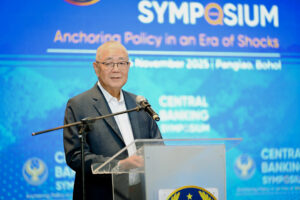PH slowing population growth opens window for faster economic growth, says expert
As the Philippines’ population growth rate has drastically slowed down, the country now has a window of opportunity to experience faster economic growth, as the working population makes up a larger share of the total population, according to an expert. “We have an opportunity to experience an economic growth that we have not seen before […]

As the Philippines’ population growth rate has drastically slowed down, the country now has a window of opportunity to experience faster economic growth, as the working population makes up a larger share of the total population, according to an expert.
“We have an opportunity to experience an economic growth that we have not seen before or could not have imagined,” said Jose “Oying” G. Rimon II, founding director of the William H. Gates Sr. Institute for Population and Reproductive Health at Johns Hopkins University’s Bloomberg School of Public Health. He told BusinessWorld on Thursday at the sidelines of the National Population, Health and Environment Conference.
“This will happen if we do the right policies and the right investment. The right investment must be in education and in health,” Mr. Rimon added.
According to the Philippine Statistics Authority (PSA), the country’s population growth rate (PGR) slowed to 0.8% annually between 2020 and 2024, from 1.63% in the 2015–2020 period.
Mr. Rimon said the lower population growth rate could lead to a decline in the young dependent population (aged 14 and below) and an increase in the working-age population, which could further support economic growth, a trend referred to as the demographic dividend.
According to the Philippine Statistics Authority (PSA), the share of the working-age population rose by one percentage point to 64% in 2020 from 63% in 2015, while the proportion of the young dependent population declined to 31% from 32% over the same period.
Meanwhile, the ASEAN+3 Macroeconomic Research Office (AMRO) said the Philippines recorded the third-fastest average growth in its working-age population at 2.27%, behind Malaysia (2.41%) and Laos (2.39%).
Mr. Rimon said the demographic dividend in the Philippines is expected to last for about 25 years—a period the government must maximize, as neighboring countries like China, Singapore, and Malaysia achieved significant growth during similar windows.
To maximize this window of opportunity, he said the government must invest in quality education, particularly by strengthening the country’s technical-vocational programs and specialized schools, especially those focused on technology.
He also emphasized the need for smoother internship programs for emerging talents.
To further expand the country’s universal healthcare access, Mr. Rimon said the Philippines could also check how government health insurance systems operate abroad.
To further expand the country’s universal healthcare access, Mr. Rimon said the Philippines could also study how government health insurance systems operate abroad. He added that the government must also ensure the health and well-being of the young dependent population. — Edg Adrian A. Eva










